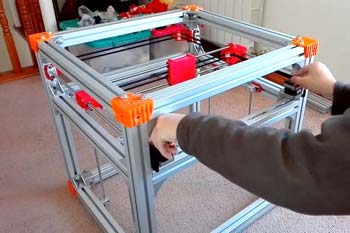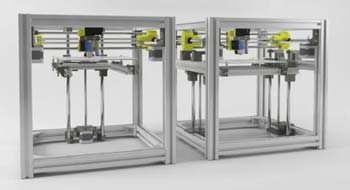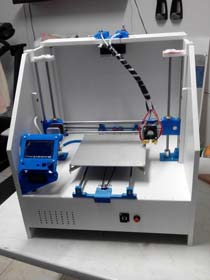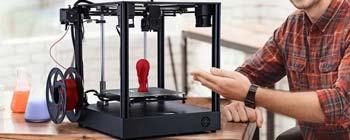
If you’re new to 3D printing, you’ve probably heard about the different types of 3D printers. Among those printers, FDM or Fused Deposition Modeling printers are hugely popular as they are affordable, offer high performance, and you can use them to create a wide range of plastic items, including mechanical parts.
FDM printers are further classified into seven categories- Cartesian, Delta, CoreXY, Polar, H-bot, Scara, and belt.
These printers are differently constructed from each other, and so they use their own kinematics when it comes to 3D printing.
To keep things simple, we are going to discuss two of the most popular printing systems- CoreXY and Cartesian.
So, if you are planning to buy a budget 3D printer but unsure about which of the two printing systems will work best for you, keep reading this CoreXY Vs Cartesian comparison!
What Is A CoreXY 3D Printer?

CoreXY is a 3D printing system inaugurated by an MIT engineer back in 2013. It is classified as Cartesian because it uses the coordinate system but in a special way.
CoreXY printers are typically cube-shaped and consist of belts and pulleys. Each belt has its own stepper motor that moves in different planes, reducing unwanted twisting of the belts when printing a 3D model.
The combined motion of the belts causes the print head to change its position at an angle of 45 degrees.
Additionally, the motors can be kept stationary in a single place, which reduces the overall weight of the 3D printer.
Read our related article on the Types of FDM 3D Printers. We cover the common FDM printer types, their uses, advantages, and disadvantages!
Advantages Of CoreXY Systems
Faster Print Speed
A big advantage of using CoreXY printers is that they have faster print speeds in comparison to other FDM printers.
Usually, other printers often have a moving gantry attached to the stepper motors or the printing bed. During the printing process, the rushing movement of the gantry causes excess vibration, which results in artifacts.
The CoreXY design features fixed stepper motors and a vertical-moving printing bed. That means the tool head is the only part of the printer that moves mass at an appreciable speed.
The entire mechanical aspect of the printer minimizes vibrations and thus eliminates artifacts.
While CoreXY printers can reach high speeds, they don’t compromise on the print quality.
High Stability
Since the X and Y stepper motors in a CoreXY printer are fixed and the moving gantry is lightweight, the overall set up provides high stability.
Compact
You will find that most 3D printers have a base that is twice the size of the build volume to ensure the printing bed can move easily, and the tool head can use the entire build area. The elongated design makes it difficult to set up the 3D printer on a workbench or enclose it.
On the other hand, a CoreXY printer has a tool head that moves in both X and Y directions, allowing easy access to the entire build plate. It doesn’t require extra space and has a small footprint, so you can place it anywhere and start printing.
Limitations Of CoreXY Systems
Tensioning Of Belts
The belts of a CoreXY printer contribute themselves to the drawback list. Since these are the crucial components of the printer, they must be properly tensioned in order for the printer to work flawlessly.
Keep in mind that the belts shouldn’t be too tight as tightening will cause them to wear and lose accuracy of the printer. If they are too loose, then it will cause ringing in the printed object, thus affecting the print quality.
Assembly
Although the frame of a CoreXY printer is more stable compared to other 3D printers, it needs to be assembled in a perfect square for flawless printing.
To make things easier, adding a corner bracket ensures the frame always remain perfectly squared.
What Is A Cartesian 3D Printer?

Cartesian 3D printers are commonly used all around the world. This type of printer uses X, Y, and Z coordinates to move the print head and print bed for printing a 3D object.
As Cartesian printers move the components linearly along the X, Y, and Z axes, they should be kept stable in order to achieve excellent print quality.
Another feature of these printers is that they use Cartesian coordinates to map out the areas to print.
Advantages of Cartesian Systems

Affordable
One of the reasons why Cartesian 3D printers are a favorite among beginners and professionals is because it lies in the affordable category.
Read More: How Hard is 3D Printing? If you’re new to 3D Printing, check out this guide before you move forward with your 3D printing hobby!
Easy To Use
Apart from being affordable, Cartesian 3D printers are very straightforward to set up. While most Cartesian 3D printers come to your doorstop fully pre-assembled, some might take as less as 5 minutes for assembly.
Precise Printing
Despite being affordable and easy to use, Cartesian 3D printers ensure precise printing. They have a mechanism that allows them to create models with a smooth texture and flawless details.
Great Support
Because of their popularity, Cartesian 3D printers have an immense community ready to provide support should you need troubleshooting.
Parts Availability
The popularity of Cartesian 3D printers also results in widespread availability of spare parts.
Limitations Of Cartesian Systems
Slower Print Speed
Since Cartesian 3D printers have a heavy print head, it takes some time to move and draw the print lines. Because of the great momentum, it can’t change direction quickly, which would otherwise, affect the print quality.
More Weight
Apart from the slow speed, Cartesian 3D printers have a large and heavy frame, which means it takes up more space.
Read More: How to Speed Up 3D Printing. If your projects are printing too slow, these tips and tricks may be able to help!
Comparing Cartesian Vs CoreXY
Setup
CoreXY 3D printers take some time and practice to assemble the components whereas Cartesian printers are easy to set up.
Speed
CoreXY printers are able to print quickly because of its lightweight structure whereas Cartesian printers take more time.
Movement
CoreXY print heads can move at an angle of 45 degrees whereas Cartesian print heads can move between 0 to 90 degrees.
Printing
CoreXY 3D printers use belts for printing whereas Cartesian printers use the X, Y, and Z coordinates.
Pricing
CoreXY printers are expensive whereas Cartesian printers are less expensive.
Bottom Line – Which One is For You?
Before you select a 3D printer, it is important to know about the purpose of 3D printing. Do you want to do it as a hobby or for business? Are you interested in creating small-sized models or large ones? Whichever decision you make, know that there is a 3D printer suitable for that specific purpose.
If you’re a beginner, it is a good idea to start with Cartesian 3D printers, and then advance to CoreXY printers. The reason is that Cartesian printers are easy to assemble, whereas CoreXY printers require a lot of practice.
Hopefully, this CoreXY Vs Cartesian guide was able to help you begin your 3D printing journey!
Other 3d printing article: